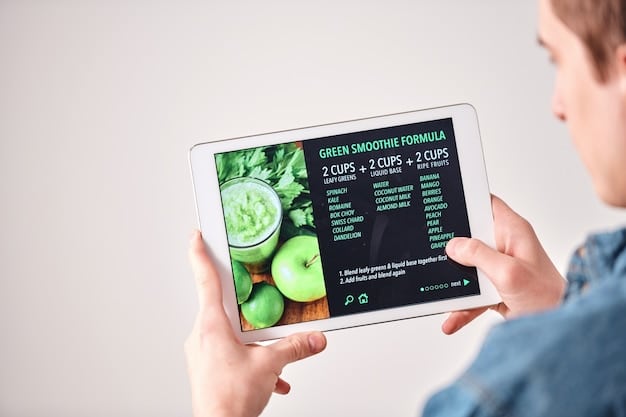Building Your Personalized Nutrition Plan for 2025

A personalized nutrition plan for 2025 integrates individual health data, lifestyle, and goals, moving beyond generic diets to create a highly effective, sustainable dietary approach tailored to unique metabolic and physiological needs.
In a world saturated with one-size-fits-all diet trends, the concept of a truly customized approach to eating has never been more relevant. This comprehensive guide, “The Ultimate Guide to Building a Personalized Nutrition Plan in 2025,” delves into how cutting-edge science and individual considerations are revolutionizing how we fuel our bodies. Discover the path to sustainable health and optimal performance through a nutrition strategy crafted uniquely for you.
The Evolution of Personalized Nutrition: Beyond Generic Diets
The landscape of nutrition has shifted dramatically, moving from broad dietary guidelines to highly individualized strategies. Gone are the days when a single diet template, like low-carb or high-fat, was universally recommended. In 2025, the focus is squarely on tailoring eating habits to an individual’s unique physiological makeup, lifestyle, and health aspirations. This evolution is driven by advancements in genomics, metabolomics, and wearable technology, allowing for an unprecedented level of insight into how our bodies interact with food.
Understanding this shift is crucial for anyone looking to optimize their health. Genetic predispositions, gut microbiome composition, and even daily activity levels all play a significant, interconnected role in how we metabolize nutrients and respond to specific foods. What works for one person might not only be ineffective for another but could potentially be detrimental. The true power of personalized nutrition lies in its ability to address these multifaceted interactions.
Why Personalization Matters More Than Ever
The sheer volume of often conflicting nutritional advice available today can be overwhelming. From social media influencers to traditional media, everyone seems to have an opinion on the “best” way to eat. This barrage of information often leads to confusion, frustration, and a cycle of short-lived dietary experiments. Personalized nutrition cuts through this noise by providing evidence-based recommendations that are directly applicable to your body.
It’s not just about weight loss or muscle gain; it’s about optimizing energy levels, improving cognitive function, reducing chronic disease risk, and enhancing overall well-being. By considering your unique biological blueprint, a personalized plan promotes sustainable habits that fit seamlessly into your life, rather than imposing restrictive regimens that are difficult to maintain long-term. This approach fosters a deeper connection with your body’s needs, transforming eating from a chore into an empowering act of self-care.
- Addresses unique metabolic profile and genetic predispositions.
- Moves beyond fads to sustainable, evidence-based practices.
- Optimizes energy, cognitive function, and long-term health.
- Reduces confusion from overwhelming, often conflicting, dietary advice.
Ultimately, personalized nutrition represents a paradigm shift. It acknowledges that human biology is incredibly diverse and that effective dietary strategies must reflect this diversity. By embracing a personalized approach, individuals are empowered to make informed choices that truly support their health and performance goals, moving beyond the limitations of generic dietary recommendations and towards a future where nutrition is truly a bespoke science. This tailored approach allows for greater adherence and superior outcomes, given its intrinsic adaptability to individual circumstances.
Key Pillars of a 2025 Personalized Nutrition Plan
Building an effective personalized nutrition plan in 2025 relies on several interconnected pillars, each contributing to a holistic understanding of an individual’s nutritional needs. These pillars include advanced data collection, scientific interpretation, behavioral integration, and ongoing adaptation. By systematically addressing each of these areas, a truly bespoke and effective plan can be constructed, moving beyond superficial dietary advice.
The first pillar involves comprehensive data collection. This goes far beyond typical dietary self-reports, incorporating genetic testing, microbiome analysis, and metabolic blood panels. Genetic testing can reveal predispositions to certain nutrient deficiencies or sensitivities, such as lactose intolerance or a slower caffeine metabolism. Microbiome analysis provides insights into the gut ecosystem, which significantly influences nutrient absorption, immune function, and even mood. Metabolic panels offer a snapshot of current bodily functions, including glucose regulation, lipid profiles, and inflammatory markers, indicating how well the body is utilizing nutrients.
Leveraging Advanced Data for Deeper Insights
Once the data is collected, the next critical step is its scientific interpretation. This requires expertise to translate complex biological information into actionable nutritional advice. For instance, a genetic predisposition for slower folate metabolism might suggest a need for more fortified foods or specific supplement forms. Similarly, a gut microbiome dominated by certain bacteria might necessitate dietary changes to foster a more balanced ecosystem, such as increasing prebiotic fiber intake or incorporating fermented foods.
The interpretation phase involves synthesizing data from multiple sources to create a coherent picture of an individual’s unique nutritional landscape. It moves beyond identifying isolated markers to understanding their interplay. For example, high inflammatory markers combined with a specific genetic variant might point towards certain dietary patterns that exacerbate inflammation, prompting modifications to reduce pro-inflammatory foods while increasing anti-inflammatory ones. This integrated approach ensures recommendations are not just based on one data point but on a comprehensive profile.
- Genomic insights: Tailoring diet to individual genetic makeup.
- Microbiome analysis: Optimizing gut health for better digestion and immunity.
- Metabolic profiling: Fine-tuning intake based on how your body processes nutrients.
- Wearable tech integration: Real-time data on activity, sleep, and physiological responses.
Beyond data and interpretation, behavioral integration is crucial. A personalized plan, no matter how scientifically sound, is only effective if it can be consistently applied. This means considering lifestyle, cultural preferences, budget, and cooking skills. Recommendations must be practical and achievable, fostering sustainable habits rather than promoting temporary fixes. This involves setting realistic goals, developing coping strategies for challenges, and creating a supportive environment. The final pillar, ongoing adaptation, acknowledges that nutritional needs evolve over time due to changes in age, activity level, health status, or even seasonal variations. A personalized plan is not static but dynamic, requiring periodic review and adjustment based on new data or changing circumstances. This iterative process ensures the plan remains relevant and effective, supporting long-term health and well-being.

The Role of Technology and AI in Personalization
The rapid advancements in technology and artificial intelligence are central to the sophistication of personalized nutrition in 2025. These tools are transforming how we gather data, interpret it, and deliver actionable insights, making highly individualized plans more accessible and precise than ever before. From wearable devices tracking real-time physiological responses to AI algorithms analyzing vast datasets, technology is enabling a level of precision previously unattainable.
Wearable technology, such as smartwatches and continuous glucose monitors (CGMs), plays a pivotal role in capturing real-time physiological data. CGMs, for instance, provide immediate feedback on how different foods affect an individual’s blood sugar levels, allowing for direct correlation between dietary choices and metabolic responses. This information is invaluable for fine-tuning carbohydrate intake and meal timing. Smartwatches track activity levels, sleep patterns, and heart rate variability, offering a comprehensive picture of energy expenditure and recovery, which directly impacts caloric and macronutrient needs.
How AI Refines Nutritional Insights
Artificial intelligence algorithms are the unsung heroes behind the interpretation of this complex, multi-modal data. AI can analyze genetic data alongside metabolic profiles and lifestyle information to identify patterns and predict optimal dietary interventions. For example, an AI could cross-reference a person’s genetic predisposition to process fats slowly with their current lipid panel results and daily activity levels to recommend specific types and quantities of dietary fats for optimal cardiovascular health.
Moreover, AI can adapt recommendations dynamically. If a person’s activity levels increase significantly, the AI might suggest a bump in caloric intake or specific nutrient timing strategies to support muscle recovery and energy. This continuous learning and adaptation capability means the personalized nutrition plan evolves with the individual, making it truly dynamic and responsive to changing needs and behaviors.
- Wearable Devices: Track real-time physiological responses (glucose, heart rate, sleep).
- AI Algorithms: Analyze vast datasets (genomic, metabolic, lifestyle) for personalized recommendations.
- Predictive Analytics: Forecast optimal dietary interventions based on individual patterns.
- Dynamic Adaptation: Adjust plans continuously as needs and behaviors evolve.
Beyond analysis, AI-powered applications are also enhancing the user experience. These apps can provide personalized meal suggestions, generate grocery lists, and even offer cooking instructions tailored to the user’s preferences and dietary restrictions. Some platforms integrate with smart kitchen appliances, further streamlining the process of preparing nutritious meals. This level of technological integration reduces the burden of adherence, making personalized eating easier and more enjoyable. The combination of advanced data collection and intelligent analysis through AI is not just about identifying what to eat but about creating a seamless, supportive environment that empowers individuals to maintain healthy habits long-term, thereby unlocking the full potential of personalized nutrition.
Practical Steps to Building Your Personalized Plan
Embarking on the journey of building your personalized nutrition plan in 2025 might seem daunting initially, given the intricate nature of the science involved. However, breaking it down into practical, manageable steps makes the process accessible and actionable. The key is to approach it systematically, starting with self-assessment and progressing through data collection, professional consultation, and iterative adjustments.
The first crucial step involves a thorough self-assessment of your current health status, lifestyle, and goals. This includes identifying any existing health conditions, energy levels, sleep patterns, stress levels, and exercise routines. Define your primary objectives: is it weight management, improved athletic performance, better digestive health, or managing a chronic condition? Being clear about your aspirations will guide the subsequent steps and ensure the plan aligns with your real-world needs.
Gathering Your Unique Biological Data
Once your personal goals are clear, the next practical step is to gather relevant biological data. This typically begins with a detailed medical history and a comprehensive physical examination by a healthcare professional. To go deeper, consider advanced testing. Genetic testing, often done with a simple saliva sample, can reveal specific genetic markers related to nutrient metabolism, food sensitivities, and predispositions to certain health conditions. Microbiome analysis, usually via a stool sample, provides insights into your gut health, identifying imbalances that might affect digestion, immunity, and even mood.
Additionally, a comprehensive blood panel can assess various metabolic markers, including blood glucose, insulin sensitivity, cholesterol levels, vitamin deficiencies, and inflammatory markers. For those with specific goals like athletic performance or managing chronic conditions, continuous glucose monitoring might be recommended to track real-time blood sugar responses to different foods and activities. This detailed data collection forms the scientific foundation upon which your personalized plan will be built.
- Initial Self-Assessment: Clarify health status, lifestyle, and goals.
- Medical & Genetic Testing: Understand predispositions and metabolic functions.
- Microbiome Analysis: Assess gut health for targeted dietary changes.
- Professional Consultation: Work with experts (dietitian, nutritionist) for interpretation.
With your data in hand, seeking guidance from a qualified professional, such as a registered dietitian or a nutritionist specialized in personalized approaches, is paramount. They can interpret complex test results, correlate them with your lifestyle and goals, and translate them into actionable dietary recommendations. This expert guidance ensures that the plan is not only scientifically sound but also practical and sustainable for your unique circumstances. Finally, remember that personalized nutrition is an ongoing process. Start with foundational changes, monitor your body’s responses, and be prepared to make gradual adjustments based on how you feel, further test results, and evolving life circumstances. This iterative approach ensures the plan remains optimized and effective over time, adapting as your body and goals change.
Navigating Challenges and Ensuring Sustainability
Even with the most scientifically sound personalized nutrition plan, navigating challenges and ensuring long-term sustainability are critical for success. The journey toward optimal health through tailored eating is rarely linear; it involves overcoming obstacles, maintaining motivation, and adapting to life’s inevitable changes. Addressing these aspects proactively is just as important as the initial plan design.
One common challenge is adherence, especially when transitioning from old habits to new ones. It’s easy to feel overwhelmed by dietary changes, grocery shopping lists, and meal preparation. To combat this, focus on gradual implementation. Instead of overhauling your entire diet overnight, introduce changes incrementally. Start by incorporating one new habit, such as adding more varied vegetables or drinking more water, before moving on to more complex modifications. Small, consistent wins build momentum and confidence.
Overcoming Obstacles and Staying Motivated
Emotional eating, social pressures, and unexpected life events (like travel or illness) can also derail a personalized plan. Developing coping mechanisms for these situations is vital. Identify your triggers for unhealthy eating patterns and devise alternative strategies. For social events, consider bringing a healthy dish to share or pre-eating a small, nutritious meal to avoid overindulging. Openly communicate your dietary needs to friends and family, seeking their understanding and support.
Maintaining motivation over time requires a focus beyond immediate results. Celebrate non-scale victories, such as increased energy, better sleep, improved digestion, or enhanced mood. Regularly review your progress with your nutritionist or health coach. Tracking food intake and symptom changes can provide valuable feedback, highlighting positive outcomes and areas that might need adjustment. This data-driven self-awareness strengthens commitment and reinforces the benefits of your personalized approach.
- Gradual Implementation: Introduce changes incrementally for better adherence.
- Coping Mechanisms: Develop strategies for emotional eating, social events, and travel.
- Non-Scale Victories: Focus on improved energy, sleep, and digestion for motivation.
- Regular Review: Monitor progress and adjust with your health professional.
Moreover, ensure your plan remains flexible and adaptable. Life is dynamic, and your nutritional needs will evolve. Factors like age, stress levels, changes in activity, or new health conditions will necessitate adjustments. A truly sustainable personalized plan is one that can be modified without being completely abandoned. This involves periodic re-evaluation, perhaps every 6-12 months, with your health professional and potentially new rounds of advanced testing to ensure the plan continues to align with your evolving biological and lifestyle needs. By anticipating challenges and building in flexibility, you can ensure your personalized nutrition plan is not just a temporary diet, but a lasting foundation for lifelong health and well-being.
Future Trends in Personalized Nutrition: What to Expect Post-2025
As we look beyond 2025, the field of personalized nutrition is poised for even more revolutionary advancements, driven by emerging technologies and a deeper understanding of human biology. The trends shaping the future will push the boundaries of individual tailoring, making nutrition an increasingly precise and preventative science. These developments promise an even more integrated, predictive, and accessible approach to dietary health.
One significant trend is the rise of continuous, non-invasive biomarker monitoring. Imagine smart toilets that analyze waste for microbiome composition and nutrient absorption, or smart patches that measure hydration and electrolyte levels in real-time. These continuous data streams will provide an unprecedented, granular view of an individual’s internal state, allowing for hyper-responsive nutritional adjustments. This moves beyond periodic testing to a dynamic, always-on assessment of metabolic needs, enabling truly just-in-time dietary recommendations.
Hyper-personalization and Predictive Modeling
Another major area of growth lies in hyper-personalization through advanced AI and predictive modeling. Future AI systems will likely integrate not only biological data but also environmental factors, psychological states, and even geopolitical events that might impact food availability or stress levels. These sophisticated models could predict an individual’s susceptibility to certain diseases weeks or months in advance based on their biological and lifestyle data, then recommend specific nutritional interventions to pre-empt their onset.
Furthermore, the integration of ‘digital twins’—virtual representations of an individual’s biology—will allow for simulated responses to different dietary scenarios without real-world experimentation. This could enable clinicians and individuals to model the impact of various foods or supplements on their unique system before making actual dietary changes, dramatically increasing the precision and safety of personalization.
- Non-Invasive Monitoring: Real-time biomarker analysis from smart devices.
- Environmental & Psychosocial Integration: AI considering broader life factors.
- Digital Twins: Simulating dietary impacts before real-world application.
- Food-as-Medicine Prescriptions: Personalized dietary interventions as primary care.
The concept of “food as medicine” will also evolve significantly. Instead of generic dietary advice for conditions, we will see highly specific, prescription-like food interventions based on an individual’s precise molecular profile. This might involve recommending specific strains of probiotics for an irritable bowel, or precise ratios of macronutrients and micronutrients to optimize brain function based on genetic markers. Accessibility will also improve; as technology becomes more ubiquitous and affordable, personalized nutrition will extend beyond the privileged few, becoming a standard component of preventative healthcare for wider populations. The future promises a nutrition landscape where dietary choices are not just informed but intricately woven into the very fabric of our personal health management, guided by intelligent systems that truly understand our unique biological needs.

Integrating Personalized Nutrition into Daily Life
Successfully integrating a personalized nutrition plan into your daily life is where theory meets practice. It’s not enough to have a scientifically perfect plan; it must also be seamlessly woven into your routines, preferences, and social landscape. This practical integration ensures long-term adherence and turns a diet plan into a sustainable lifestyle. The key lies in strategic planning, mindful eating, and fostering a supportive environment.
Start by planning your meals and snacks in advance. This doesn’t mean every meal needs to be gourmet; it means having a general idea of what you’ll eat. Utilize digital tools or apps that can help organize your personalized recommendations, generate grocery lists, and even suggest recipes tailored to your needs. Batch cooking on weekends can save significant time during busy weekdays, ensuring you always have healthy options readily available and reducing the temptation for less optimal choices.
Mindful Eating and Adapting Routines
Beyond what you eat, how you eat is equally important. Practice mindful eating by paying attention to hunger and fullness cues, savoring your food, and eating without distractions. This helps in better digestion and a deeper connection to your body’s signals, reinforcing the personalized nature of your plan. Understanding why certain foods are recommended for you—based on your unique data—can also increase motivation and adherence. This internal understanding makes healthy choices feel more empowering than restrictive.
Adapting your routines to support your nutrition plan might involve slight shifts in your schedule. Perhaps it’s setting aside time for meal prep, finding a new grocery store that stocks specific ingredients, or adjusting your exercise timing to better align with your nutrient intake. These small adjustments, when consistent, create a structured environment that makes following your personalized plan feel natural rather than forced.
- Strategic Meal Planning: Use apps for recipes and grocery lists.
- Batch Cooking: Prepare meals in advance for busy weekdays.
- Mindful Eating: Pay attention to hunger cues; eat without distractions.
- Adapting Routines: Integrate meal prep and grocery shopping into your schedule.
- Social Support: Communicate your needs to friends and family.
Finally, fostering a supportive social environment can significantly impact your success. Inform close friends and family about your personalized nutrition journey and explain its importance to your health. Request their understanding and support, whether it’s by choosing restaurants with suitable options or respecting your dietary choices at gatherings. While not everyone may fully grasp the nuances of personalized nutrition, their awareness can help avoid situations that undermine your efforts. Integrating personalized nutrition isn’t about perfection; it’s about consistency, flexibility, and a commitment to nurturing your unique body, transforming your diet into a tailored blueprint for lifelong vitality.
| Key Point | Brief Description |
|---|---|
| 🧬 Data-Driven | Utilizes genomics, metabolomics, and microbiome data for precise insights. |
| 🤖 AI & Tech-Enabled | AI analyzes complex data; wearables track real-time physiological responses. |
| 🧘♂️ Holistic & Adaptable | Considers lifestyle, goals, and adapts to evolving health needs over time. |
| 🌱 Sustainable Wellness | Focuses on long-term adherence and integration into daily life for lasting health. |
Frequently Asked Questions About Personalized Nutrition
Unlike traditional, generic diets, personalized nutrition tailors dietary recommendations to your unique genetic makeup, metabolic profile, and lifestyle. It uses data from advanced tests like genomics and microbiome analysis to create a plan that is specifically optimized for your body’s needs, leading to more effective and sustainable health outcomes.
The initial investment in genetic testing, microbiome analysis, and professional consultation can be significant. However, considering the potential long-term health benefits, reduced risk of chronic diseases, and avoidance of ineffective dietary fads, many find the cost worthwhile. As technology advances, accessibility and affordability are expected to improve.
AI algorithms analyze vast amounts of complex biological and lifestyle data to identify unique patterns and predict optimal dietary interventions. It can process information from genetic tests, wearable devices, and metabolic panels, providing dynamic, evolving recommendations that adapt as your body and needs change, ensuring ongoing optimization.
While self-assessment is helpful, interpreting complex genetic and metabolic data requires specialized expertise. Consulting a registered dietitian or nutritionist with experience in personalized approaches is highly recommended. They can translate scientific findings into practical, safe, and effective dietary strategies tailored to your specific health goals and real-world circumstances.
Results vary widely based on individual goals, adherence, and baseline health. Some may notice improvements in energy or digestion within weeks, while others might take months to see significant changes in weight or chronic conditions. Personalized nutrition is a long-term journey focused on sustainable health and well-being, rather than quick fixes.
Conclusion
The landscape of nutrition is undeniably shifting towards a future where dietary guidance is as unique as our fingerprints. “The Ultimate Guide to Building a Personalized Nutrition Plan in 2025” underscores this paradigm shift, revealing how advancements in genomics, AI, and continuous monitoring are making truly bespoke nutrition not just a theoretical concept but a tangible reality for optimizing health. By embracing a data-driven, professionally guided, and adaptable approach, individuals can transcend the limitations of generic diets and unlock their unique potential for sustained vitality and well-being. The journey is not without its challenges, but with the right tools and mindset, personalized nutrition offers a powerful blueprint for a healthier, more resilient future.





